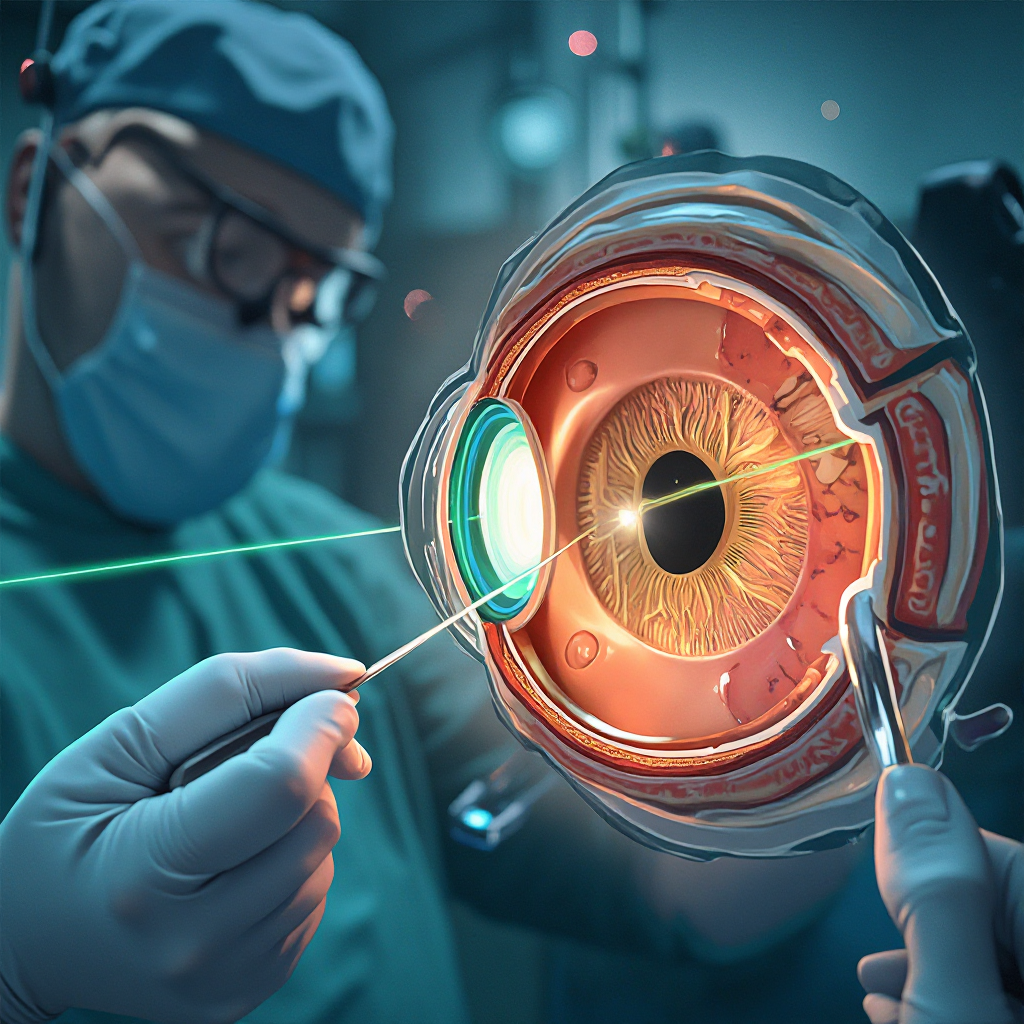Unlocking Clarity: Discover How Laser Eye Surgery Works
Unlocking Clarity: Discover How Laser Eye Surgery Works
Unlocking Clarity: Discover How Laser Eye Surgery Works
How about a morning with perfect vision, where there is not a pair of glasses on the nightstand and no contact lens to bother about? This is what laser eye surgery promises and indeed this surgery has revolutionized the life of millions of people in things they do everyday. With the ability to remodel the cornea via the accurate use of light beams, laser eye surgery brings an added freedom to individuals whose vision is compromised by the impediment of slightness of view, farsightedness or astigmatism.
So how does the laser eye surgery work? So what are the things you should know before determining whether it is right or not to you? There is need to know the science behind this treatment process which is popular. It enables you to have the courage and informative options on matters that concern your vision.
Either you are a candid person to undergo the procedure, or you are a wishful thinker who is just trying to explore what the technology offers, educating yourself can open a door of clarity. So, suit up and get ready to see clearly with us as to go behind the scenes of the process of consultation to crystal-clear sight, and even answer the question whether this life-altering procedure can be the next step towards your future or not.
What is Laser Eye surgery?
Laser eye surgery refers to the modern medical procedure, which is invented to save people, who experience frequent visual issues, and achieve a healthy visual display by restructuring the transparent anterior portion of the eye, called the cornea. The highly non-invasive treatment enables a great number of patients to decrease or even do away with the use of glasses or contact lenses.
Undoubtedly the best-known form of laser eye operation is the LASIK surgery (Laser-Assisted In Situ Keratomileusis), as with LASIK the surgery has become all but interchangeable with vision correction within the last few years. Still, it is not the only method, and PRK (Photorefractive Keratectomy), and SMILE (Small Incision Lenticule Extraction) are also available with their contribution to benefits depending on requirements.
The given procedures are mostly focused on the treatment of refractive errors, which are associated with the inability of the eye to focus the light strictly on the retina due to its shape. One of the most widespread such diseases that may be solved with the help of laser eye surgery is myopia, or nearsightedness, when far things are blurred and everything close is clear.
On the one hand, Hyperopia (Farsightedness) makes the close objects difficult to read, and Astigmatism leads to weak overall vision and blurred vision as a consequence of the irregularity of the cornea. Laser eye surgery works by accurately changing the curves of the cornea to achieve focus of the light to give better vision.
Laser eye surgery is versatile such that in most cases it can correct more than one refractive problem during surgery. As an illustration, a person with myopia and astigmatism can enjoy a tailored LASIK surgery because it is used to address both issues at the same time. Such flexibility has also contributed to its wide use by active sports people and other professionals as well as other individuals interested to live an active lifestyle free of the binding nature of glasses and spectacles.
Knowing the process of laser eye surgery will enable the prospective applicants to effectively decide regarding their eye health. It is not only about having a better vision, but about the feeling of confidence and comfort in life. With all the new ages of technology grabbing momentum, the scope of ailments that can be treated and the success of the various processes involved here only continue to increase, with new possibilities being offered to everybody who wishes to open a world filled with a visual clarity.
The Laser Eye Surgery Science
The essence of laser eye surgery is a bizarre case of hi-tech and the science of seeing. The main aim of the procedure is reshaping the cornea, which is a transparent covering on the front part of your eye, through the very high degree of precision laser light rays.
Cornea is the primary lens of the eye and hence a small defect in the shape of the cornea may cause the light to fall on the retina improperly due to which the vision gets blurred. Through restructuring the cornea, doctors are able to assist the eye to bend in a wavelength more precisely, reversing problems such as shortsighted (myopia), shortsighted (hyperopia) and astigmatism among others.
In order to remember why this works, imagine that the eye is like a camera. The cornea is compared to the lens of the camera- it must be ideal in its configuration so that it causes things to be into proper focus. An extreme curvature of a lens or a very shallow one results into blurred image.
During laser eye surgery, lasers which are computer guided, produce cool beams of ultraviolet light, which allow removal of minute sizes of corneal tissue with precision. This process is precise to a level that it can rectify vision up to fractions of a diopter the unit of measurement of refractive error in an eye.
It is difficult to overestimate the role of optics in the process. When light enters the eye through the cornea; it further travels through the lens and falls on the retina at the back of the eye. When the shape of the cornea is inaccurate, light rays are scattered or clubbed together in an incorrect way and that causes distorted vision.
The application of laser in recontouring the cornea optimizes optical alignment, thus allowing the clean focus of light onto the retina by the surgical doctor. In practice, laser surgery in the eye tailors how your eye uses light, so that the world looks a lot clearer and vivid.
The most distinct superiority of the modern laser eye surgery lies in the possibility to customize the treatment to the individual eye structures. Cutting-edge technologies like wavefront mapping are able to provide a precise map of the cornea someone with an extremely fine resolution, enabling them to think extra accurately at point of surgery.
The individual treatment this involves implies that the results are not only safer but also better predictable which enables millions to experience a sharpened vision and the independence of corrective devices.
The Procedure Step by Step
All of the patients take part in the pre-operative assessment before the journey to better vision has begun. This is a set of eye tests to identify the exclusive cornea, the diameters of the pupils as well as the tear production. Medical history and lifestyle aspects are also examined by specialists to make the person an apt candidate of laser eye surgery.
As an example, an active person may speak about how correction of vision may affect such activities as swimming or contact sports, whereas a person with specific health issues will have to mention other measures.
Patients will be among the beneficiaries on the procedure day since they will experience a smooth and effective process. Eye drops are used to numb the eye and the peri ocular area is wiped dry. With the application of sophisticated laser technology, the surgeon forms an ultra-thin flap within the cornea (in the procedure of LASIK), or she/he removes gently the top surface of the tissue (in the procedure of PRK).
Laser is then used to reform the underlying corneal tissue as per highly precise measurements mainly made during assessment phase. The actual surgery takes only a few minutes, and because of no pain and with only minor feelings, most patients find it surprising that the actual surgery takes an average of 15 minutes per eye or less.
Service after surgery can be the key to the best outcome and recovery. After the procedure patients mostly rest briefly and then they are usually given leave to go home and in most cases wearing eye protection. Eye drops are administered to eliminate infection risks and to treat dryness and future visits are planned to check recovery.
Occasionally, you may feel a little nuisance or blurriness in your vision during the first day or two of wearing them, but the vast majority of people experience tremendous improvements with their vision in 24 to 48 hours. Following after care services which include not rubbing the eyes and not engaging in intense exercises will contribute to the best results in laser eye surgery.
Knowing more thoroughly the mechanism of laser eye surgery step by step enables patients to make an informed decision regarding the vision correction process. Every stage, be it assessment or recovery has been calculated and bears in mind precision and care thus providing a sense of assurance as opposed to a clearer vision in future.
Technology Adapted in Laser Eye Surgery
The secret behind the success of laser vision correction is modern surgery technology that combines precision engineering and the most recent scientific medical advances. The lasers are excimer and femtosecond lasers and are used to remodel the cornea in microscopic precision.
The excimer lasers are the lasers which employ the ultraviolet M to etch away small slivers of tissue and the femtosecond lasers make crisp incisions in their corneas without having to utilize a customary blade. Distinct behavior disclosed by computer-controlled systems uses such advanced staging tools, which make sure to enter the measurements of the individual eyes of each patient into every activity of operation.
Advances in the field of eye surgery technology have dramatically increased the level of safety and outcomes. As an example, real time eye-tracking systems are being used in surgery where even the smallest movements of the eye are tracked and the path of the laser automatically keeps up with it.
The other breakthrough is the wavefront-guided LASIK surgery, which scans the surface of the eye in exquisite detail, and enables personal correction to not only the typical flaws of refractive error vision, but of optical imperfections as well. The innovations have minimized complications and enhanced predictability of outcome and therefore patients have more confidence in the procedure.
Comparing various laser technologies, it is possible to mark two most common by the number of procedures, and it is LASIK (Laser-Assisted In Situ Keratomileusis) and PRK (Photorefractive Keratectomy). LASIK entails a microscopically thin incision of the eye surface, the cornea with femtosecond laser, and then alternates or changes the underlying structure with a excimer laser this usually results in faster healings and less pain.
Compared to PRK, however, the outer layer of the cornea is taken completely away prior to reshaping, thus making it a good option with patients whose corneas are thinner or have specific lifestyle factors involved. Both practices take advantage of the latest available eye surgery technology, which is definitely good, but they both provide different benefits depending upon the specific patient requirements and eye conditions.
Due to the constantly changing technology it is possible that new adaptations of the procedure are being discovered like SMILE (Small Incision Lenticule Extraction) which shows to be even less invasive and with little effect on cornea integrity.
These new advances are not only facilitating the popularity of laser eye as surgery as becoming safer and more effective but also opening vision correction to the increasing numbers of patients. To get knowledge of the technology involved in LASIK, or the option of PRK or the newer ones, have knowledge on the technologies can enable you to make the best decision about your vision and about your future.
Advantages of Eye Laser Surgery
The most exciting asset of laser eye surgery is the remarkable improvement of vision results. A percentage of patients who have other procedures such as LASIK or PRK have claimed to have been able to see 20/20 or even better within a few days after the recovery process.
This newfound acuity does not only imply that one can see an eye chart better; this comes to life scenario, i.e., a person can safely drive at night, play any sport without having to wear glasses, or just open his/her eyes to a clear world every morning. The high-tech surgery with laser guarantees thoroughness that every treatment will be a customized one to satisfy the individual specific visual requirement and therefore this will maximize the chance of attaining remarkable outcome.
In addition to visual acuity, laser eye surgery may also have enormous long run cost savings against the repetitive expenses of glasses and contact lens. Think of the recurring cost of buying new frames, prescription lenses, cleaning agent and routine eye check ups to update lenses.
The cost eventually is something that amounts to something worthwhile in the long run, thus providing an economical procedure that offers priceless vision in the future. This may cost, but is only a one-off procedure, yet can save young adults many decades of spectacles, contact lens and other eyewear costs, which saves a lot of funds to pursue other life ambitions and interests.
The other strong point that attracts many individuals to laser eye surgery is convenience. You will never again be afraid of losing your glasses or breaking them, and of uncomfortable sensations in the eyes because of contact lenses. Such things as swimming, hiking or travelling will be a lot easier now when there is no need to take care of corrective glasses.
To people who are active and tech-savvy, the opportunity that laser vision correction offers in terms of freedom and flexibility can literally be life changing. Laser eye surgery helps to improve both the short-term and life quality by enabling one to experience random tours or concentrate on the job without vision disruptions.
After all, a better vision, savings, and convenience of everyday life make the laser eye surgery a complete revolution in the life of many people. This procedure will bring possibilities made by the use of the latest technology and precise surgical skills meaning that people will not only see better but also live fuller lives.
Risks and considerations
Laser eye surgery, or refractive surgery, is an amazing operation entailing a lot of advantages to a good number of patients. However, prior to proceeding with the operations, it is best that people familiarize themselves with the risks and factors involved. Other people might feel certain temporary adverse effects with the most frequent ones being a dry eye, glare, halos around lights or a slight discomfort during the first few weeks of healing.
Somewhere in a fairly unique case, complications can be seen under-correction, over-correction, or infection and this may need additional treatment or improvement process. Even though these times have been relieved by modern development, it is important to know that there is a possibility of this happening in order to have realistic expectations.
Some personal considerations should be taken into consideration when laser eye surgery is concerned. Age is a factor of consideration; an example is that one cannot be considered a candidate to eye surgery under the age of 18 people can still change their vision. Also, some medical conditions can have an influence on candidacy and outcomes, including autoimmune diseases, unmanageable diabetes, or serious cases of dry eye syndrome.
An example in point would be the case of a patient with thin corneas that might make certain form of refractive surgery more or less apt, or that should just not perform it altogether. The process of decision-making may also be affected by elements of lifestyle, e.g. engaging in contact sports or some line of work.
These variables being decades away, a blood-to-blood consultation with an expert eye care specialist is a must. In this test, your ophthalmologist will carry out thorough eye tests and will also talk over your medical history to consider whether or not you are a good refractive surgery patient.
This is also the opportunity to raise concerns and questions that might arise concerning what you think about the dangers involved or concern about your life after surgery. By staying open with your provider, it is guaranteed that you will receive exclusive advice that will meet your specific needs and situations.
Finally, the secret to success lies within the properly informed decision making. Considering the costs and benefits as well as seeking advice of experts gives you the power to make decisions that make you move towards your vision goals and well-being. Proper pre-surgery preparation and assistance can help the patient realise that laser eye surgery will provide more clarity even than the risks it may cause are likely to do.
The Frequently Asked Questions
Unsurprisingly, when you think of laser eye surgery, you might end up with a lot of questions. The most asked question is, how long does the good vision stay? In the majority of patients, the outcome is a permanent one, but later in life, the consequences of natural changes in the eye, which is the eye ageing, e.g. development of presbyopia or cataracts, may still develop.
The other common question is related to the pain during the procedure. Laser vision correction is usually pain free, i.e., drops are applied to numb your eyes, and those that still have mild pain during the recovery period can be cured within a day, though it only may take two.
There exist a lot of myths concerning the functioning of laser eye surgery. Other individuals are afraid that the laser can burn a hole through the eye or that they can make errors by blinking. The reality is, that even the slightest movements of the eyes are being followed by the advanced technology and a pause will be made automatically in case the person requires it, which makes the process incredibly safe.
The other myth is that it takes weeks to heal. Surprisingly, most patients experience significant clarity in vision after a span of 24hours but the nature of post-operative support including; applying the recommended eye drops, and prevention of any strenuous activities largely determines the extent of recovery.
To the people who have been wondering whether everyone is a candidate, it is a nuanced argument. Two important factors include age, the thickness of the cornea, general health and prescription stability. You need to meet with a highly qualified eye care specialist to have a thorough check-up and then discuss expectations about your individual case.
The American Academy of Ophthalmology and the online site of the FDA Information on laser vision correction may be called good sources of further information in case you need it. Educational seminars at a large number of clinics or contacting people who have already conducted surgery are also provided. The opportunities will serve an eye opener and confidence booster when you seek information on whether laser eye surgery suits you.
Experiences and Testimonials by Patients
A session with people who have undergone laser eye surgery first hand can give a valuable insight to the persons interested in the surgery. Consider the example of Sarah, a 32-year-old graphic designer, who had issues with glasses fogging every morning on the way to work after a run in the morning or contacts causing her to get irritated eyes at the office.
Sarah had research and discussed with her ophthalmologist the advantages of laser eye surgery so she opted to get LASIK. The next day, she reports that waking up was life changing; she could clearly see the world with no corrective lenses. The convenience and freedom that Sarah experienced proved just as important, as the better vision itself.
There is yet another interesting tale of a person called Mark, aged 45, who as a young boy always wore a pair of thick glasses because he was very shortsighted. The main reason why Mark wanted to distribute siFurnaces to his active kids was to make sure that his children do not think of that possibility of broken and lost glasses.
Talking to his adviser and being informed about the recent developments in the laser field, he chose PRK, as this procedure is suggested to the one with such an eye structure. His recovery was a bit slower than LASIK though, but now Mark has 20/20 vision and feels superior in and out of the classroom.
These experiences of patients do not only explain the physical advantages of laser eye surgery, such as seeing better and not being in need of corrective lenses, but also emotional and lifestyle improvements that laser eye surgery brings to people.
There are numerous cases of patients feeling very confident, spontaneous, and independent following the surgery. It can be playing a sport, traveling with ease of movement, and just seeing clearly every morning, positive effects of the mentioned can be far-reaching.
Based on their experience, patients often underline that comprehensive research, healthy expectations, and open communication with their eye care providers are the key to safe journeys. Although some of them at first were nervous during the procedure, most of them felt comfortable once they knew the procedure and realized that they were in professional hands.
A threading aspect of their stories is about average citizens attempting to improve their lives through a medical procedure such as laser eye surgery, it is not only a medical procedure but an investment in quality of life.
The Age of a Brighter Future
Laser eye surgery has transformed the manner in rectifying eyesight. In this article, we have had an insight into how laser eye surgery works, the science behind the process of changing the shape of the cornea, the technologically advanced procedures, and what one should observe before, during or after laser eye surgery. We have also explained various advantages, possible dangers and the real life encounters of persons who have gone through this life changing treatment.
To think of laser eye surgery, bear in mind that each pair of eyes is very different. Address to a professional eye care specialist to talk about the possibilities and receive some individual recommendations. Under proper guidance, you will be able to make an informed choice on whether this life changing procedure is appropriate to you. Laser eye surgery not only gives you better vision, but a life of enhanced freedom and confidence to see a better and more colourful world in the future.
How laser eye surgery works
laser eye surgery, LASIK procedure, cornea reshaping, vision correction, eye surgery technology, surgical precision, refractive surgery, post-operative care, benefits of laser eye surgery, patient experience,
individuals considering vision correction, patients exploring laser eye surgery, eye care enthusiasts, healthcare professionals, tech-savvy readers,







Looking for a reliable eye hospital in Bhiwandi? Visit Anushka Eye Hospital for expert treatment and modern care. Moreover, Anushka Eye Hospital offers expert cataract eye surgeons in Bhiwandi for safe and modern surgeries. Get advanced cataract care from a skilled cataract eye doctor in Bhiwandi at Anushka Eye Hospital. Book your visit now and see better, sooner!